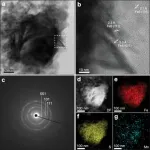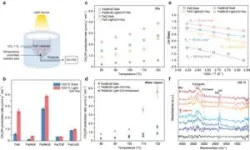(Press-News.org) An international team of scientists recently published a study highlighting the potential role of iron sulfides in the formation of life in early Earth’s terrestrial hot springs. According to the researchers, the sulfides may have catalyzed the reduction of gaseous carbon dioxide into prebiotic organic molecules via nonenzymatic pathways.
This work, which appeared in Nature Communications, offers new insights into Earth’s early carbon cycles and prebiotic chemical reactions, underscoring the significance of iron sulfides in supporting the terrestrial hot springs origin of life hypothesis.
The study was conducted by Dr. NAN Jingbo from the Nanjing Institute of Geology and Paleontology, Chinese Academy of Sciences, Dr. LUO Shunqin from Japan’s National Institute for Materials Science, Dr. Quoc Phuong Tran from the University of New South Wales, Australia, and other researchers.
Iron sulfides, abundant in early Earth’s hydrothermal systems, may have facilitated essential prebiotic chemical reactions, similar to the function of cofactors in modern metabolic systems. Previous studies on iron sulfides and the origin of life have focused primarily on deep-sea alkaline hydrothermal vents, which provide favorable conditions like high temperature, pressure, pH gradients, and hydrogen (H₂) from serpentinization—factors thought to support prebiotic carbon fixation.
However, some scientists have proposed terrestrial hot springs as another plausible setting for life’s origins, due to their rich mineral content, diverse chemicals, and abundant sunlight (Figure 1).
To explore the role of iron sulfides in terrestrial prebiotic carbon fixation, the research team synthesized a series of nanoscale iron sulfides from mackinawite (Figure 2), including pure iron sulfide and iron sulfides doped with common hot spring elements such as manganese, nickel, titanium, and cobalt.
Their experiments showed that these iron sulfides could catalyze the H₂-driven reduction of CO₂ at specific temperatures (80–120 °C) and atmospheric pressure. Gas chromatography was used to quantify the methanol production (Figure 3).
The study found that manganese-doped iron sulfides exhibited notably high catalytic activity at 120 °C. This activity was further enhanced by UV-visible (300–720 nm) and UV-enhanced (200–600 nm) light, suggesting that sunlight might play a role in driving this reaction by facilitating chemical processes. Additionally, the introduction of water vapor boosted catalytic activity, further supporting that vapor-laden terrestrial hot springs may have served as key sites for nonenzymatic organic synthesis on early Earth.
To further investigate the mechanism behind the H₂-driven CO₂ reduction, the team conducted in-situ analyses using diffuse reflectance infrared Fourier transform spectroscopy (DRIFTS).
Results indicated that the reaction likely proceeds via the reverse water-gas shift (RWGS) pathway, in which CO₂ is first reduced to carbon monoxide (CO), which is subsequently hydrogenated to form methanol. Density functional theory (DFT) calculations provided additional insights, revealing that manganese doping not only lowered the reaction’s activation energy but also introduced highly efficient electron transfer sites, thereby enhancing reaction efficiency (Figure 4). The redox characteristics of iron sulfides make them functionally analogous to modern metabolic enzymes, providing a chemical foundation for prebiotic carbon fixation.
This research underscores the potential of iron sulfides to catalyze prebiotic carbon fixation in early Earth’s terrestrial hot springs, opening new directions for exploring life’s origins and supporting efforts to search for extraterrestrial life.
END
Scientists reveal possible role of iron sulfides in creating life in terrestrial hot springs
2024-11-28
ELSE PRESS RELEASES FROM THIS DATE:
Hormone therapy affects the metabolic health of transgender individuals
2024-11-28
New research from Karolinska Institutet shows that long-term sex hormone treatment in transgender individuals can lead to significant changes in body composition and risk factors for cardiovascular disease, particularly in transgender men. The study is published in the Journal of Internal Medicine.
“We saw that transgender men treated with testosterone increased their muscle volume by an average of 21 percent over six years, but also that the amount of abdominal fat increased by 70 percent,” says Tommy Lundberg, docent at the Department of Laboratory Medicine, Karolinska Institutet. “In addition, they had more liver ...
Survey of 12 European countries reveals the best and worst for smoke-free homes
2024-11-28
Seven out of ten homes in Europe are smoke-free, according to a major survey published today (Thursday) in ERJ Open Research [1]. However, some countries have come further than others in protecting children and adults from second-hand tobacco smoke in the home.
Greece came out bottom of the 12 countries in the survey, with smoking allowed in more than half of homes. In Romania, Bulgaria and Spain more than four in ten homes allow smoking to take place. England scored the highest out of the 12, with more than eight in ten homes smoke-free, with Ireland, Latvia and Italy following next.
The researchers say that the ...
First new treatment for asthma attacks in 50 years
2024-11-28
An injection given during some asthma and COPD attacks is more effective than the current treatment of steroid tablets, reducing the need for further treatment by 30%.
The findings, published today in The Lancet Respiratory Medicine, could be “game-changing” for millions of people with asthma and COPD around the world, scientists say.
Asthma attacks and COPD flare-ups (also called exacerbations) can be deadly. Every day in the UK four people with asthma and 85 people with COPD will tragically die. Both conditions are also very common, in the UK someone has an asthma attack every ...
Certain HRT tablets linked to increased heart disease and blood clot risk
2024-11-28
Certain hormone replacement therapy (HRT) tablets containing both oestrogen and progestogen are associated with a higher risk of heart disease and rare but serious blood clots known as venous thromboembolism (VTE) in women around the age of menopause, finds a study from Sweden published by The BMJ today.
Another HRT tablet called tibolone was associated with an increased risk of heart disease, heart attack and stroke, but not blood clots, “highlighting the diverse effects of different hormone combinations and administration methods on the risk of cardiovascular disease,” say the researchers.
HRT is used to relieve menopausal ...
Talking therapy and rehabilitation probably improve long covid symptoms, but effects modest
2024-11-28
Cognitive behavioural therapy (CBT) and a programme of physical and mental rehabilitation probably improve symptoms of long covid, but the effects are modest, finds a review of the latest evidence published by The BMJ today.
Intermittent aerobic exercise also probably improves physical function compared with continuous aerobic exercise. But the researchers found no compelling evidence to support the effectiveness of other interventions, including certain drugs, dietary supplements, inspiratory muscle training, transcranial ...
Ban medical research with links to the fossil fuel industry, say experts
2024-11-28
An investigation published by The BMJ today reveals the extent of fossil fuel industry involvement in medical research, leading to fresh calls for academics and publishing companies to cut ties with companies.
An analysis by journalists Hristio Boytchev, Natalie Widmann and Simon Wörpel found that over the past six years, more than 180 medical articles have acknowledged fossil fuel industry funding, and an additional 1000 articles feature authors who worked for a fossil fuel company or related organisation.
While many studies don’t have an obvious link with fossil fuel industry interests, experts told The BMJ that publishing research ...
Different menopausal hormone treatments pose different risks
2024-11-28
Researchers at Uppsala University have analysed the effects of seven different hormone treatments for menopausal symptoms on the risk of blood clots, stroke and heart attack. The study, which involved around one million women aged between 50 and 58, shows that the risks differ depending on the active substance and how the medicine is taken. Published in the scientific journal BMJ, this is the largest and most comprehensive study of currently prescribed hormonal substances in the world.
“There is concern among women that menopausal hormone therapy increases the risk of cardiovascular disease. This concern is based on older studies conducted more than ...
Novel CAR T cell therapy obe-cel demonstrates high response rates in adult patients with advanced B-cell ALL
2024-11-27
Patients with relapsed or refractory CD19-positive B-cell acute lymphoblastic leukemia (ALL) who were treated with the novel anti-CD19 chimeric antigen receptor (CAR) T cell therapy, obecabtagene autoleucel (obe-cel), experienced high response rates and most did not need a subsequent stem cell transplant (SCT), according to results from the Phase Ib/II FELIX trial co-led by researchers at The University of Texas MD Anderson Cancer Center.
The findings, published today in the New England Journal of Medicine, ...
Clinical trial at Emory University reveals twice-yearly injection to be 96% effective in HIV prevention
2024-11-27
For oral medications that prevent new HIV infection to be effective, the patient must take certain actions, including attending doctor’s visits every three months and – most importantly – consistency.
These daily oral antiretrovirals, more commonly referred to as PrEP (pre-exposure prophylaxis), such as Truvada®, are extremely effective at HIV prevention, but only if they are taken daily as directed. Truvada’s efficacy is greatly compromised when taken inconsistently.
However, results from a recent Gilead-funded clinical trial (Purpose-2) led by physicians at Emory University ...
Discovering the traits of extinct birds
2024-11-27
Looking to inform the conservation of critically endangered bird species, University of Utah biologists completed an analysis identifying traits that correlate with all 216 bird extinctions since 1500.
Species most likely to go extinct sooner were endemic to islands, lacked the ability to fly, had larger bodies and sharply angled wings, and occupied ecologically specific niches, according to research published this month.
While some of these findings mirror previous research on extinct birds, they are the first to correlate bird traits with the timing of ...






